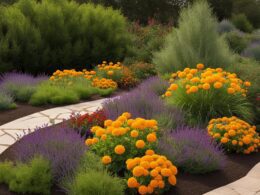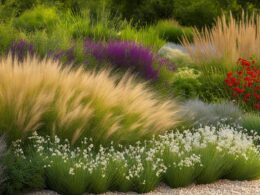Mulching is an essential technique for effectively controlling weeds in xeriscape gardens. By following these pro tips, you can easily maintain a weed-free, beautiful, and water-efficient landscape.
Key Takeaways:
- Mulching is a crucial step in maintaining a weed-free xeriscape garden.
- Observing and designating sun and water zones is important for planning your xeric garden.
- Choose drought-tolerant plants that thrive in Colorado’s specific conditions.
- Removing the grass lawn can be done through various methods, including a turf replacement program.
- Proper planting techniques and the use of mulch help in plant growth and weed suppression.
Step 1: Observing and Designating Sun and Water Zones
Before embarking on your xeriscape journey, it’s essential to understand the sun and water patterns in your yard. By observing and designating sun and water zones, you can optimize the placement of your plants and ensure proper water usage. This step will help you create hydrozones, which are areas in your garden with similar water requirements.
To get started, spend some time in your yard at different times of the day to observe how sunlight moves across the space. Take note of areas that receive full sun, partial shade, or full shade. This information is crucial for selecting plants that thrive in specific light conditions.
Next, consider the natural water patterns in your yard. Identify areas where water tends to accumulate, such as low-lying spots or areas near downspouts. These are potential spots for plants that prefer moist soil. Conversely, mark areas that receive less water or are prone to dryness. These zones will be ideal for plants that have high drought tolerance.
Once you have observed and designated your sun and water zones, you can proceed to plan and design your xeric garden more effectively. This initial step sets the foundation for creating a harmonious and water-efficient landscape that will thrive in the specific conditions of your yard.
Step 2: Choosing Drought-Tolerant Plants for Colorado
Choosing the right plants for your xeric garden in Colorado is crucial to ensure their survival in the region’s unique climate and conditions. By selecting drought-tolerant plants, you can create a beautiful and sustainable landscape that requires minimal water.
Factors to Consider
When choosing drought-tolerant plants, consider the following factors:
- Climate: Colorado experiences a range of temperatures and weather patterns, including hot summers and cold winters. Select plants that can withstand these extremes.
- Soil Type: Colorado soil varies across the state, from sandy to clay-based. Determine your soil type and choose plants that thrive in those conditions.
- Water Availability: Since xeric gardens are designed to be water-efficient, select plants that have low water requirements and can thrive with minimal irrigation.
Recommended Drought-Tolerant Plants for Colorado
Garden in a Box, a program offered by local conservation organizations, provides pre-designed garden collections of drought-tolerant plants specifically selected for Colorado’s climate. These collections include a variety of native and adapted plants that are well-suited for xeriscaping.
| Plant Name | Water Requirements | Sun Exposure | Height |
|---|---|---|---|
| Blue Flax | Low | Full Sun | 1-2 ft |
| Purple Coneflower | Low | Full Sun to Part Shade | 2-5 ft |
| Butterfly Weed | Low to Moderate | Full Sun | 1-2 ft |
| Yarrow | Low | Full Sun | 1-3 ft |
These are just a few examples of the many drought-tolerant plants available for xeric gardens in Colorado. Consult with local nurseries or gardening experts to discover more options that suit your preferences and garden design.
“Choosing drought-tolerant plants is the key to a successful xeric garden in Colorado. By selecting plants that can thrive in the state’s climate and soil conditions, you can create a stunning landscape that conserves water and reduces maintenance.” – Garden Expert
Step 3: Removing the Grass Lawn
Transitioning from a traditional grass lawn to a xeric garden is a crucial step in the process of xeriscaping. Removing the grass effectively ensures that your new water-efficient landscape can thrive without the competition from grassy areas. There are several methods you can use to remove the grass, including physical removal, solarization, and sheet mulching. Additionally, taking advantage of a turf replacement program can make this step easier and more efficient.
Physical removal involves manually digging up the grass and its root system using a shovel or other gardening tools. This method is labor-intensive but allows for precise clearing of the grass. Solarization, on the other hand, utilizes the sun’s heat to kill the grass. To solarize your lawn, cover it with a clear plastic sheet for several weeks to create a greenhouse effect that steams the grass and eliminates it.
Sheet mulching is another effective approach to grass removal. This method involves layering materials over the grass to smother it and create a nutrient-rich foundation for your xeric garden. Start by mowing your lawn as short as possible and then covering it with cardboard or several layers of newspaper. Add a layer of compost or organic matter, followed by a layer of mulch. This process gradually breaks down the grass while nourishing the soil beneath.
Utilizing a turf replacement program can provide additional support during the process of grass lawn removal. These programs often offer resources, such as guidance on preferred removal methods, access to equipment rentals, and even financial incentives. Check with your local government or water conservation organizations to see if there are any turf replacement programs available in your area.
Table: Pros and Cons of Grass Lawn Removal Methods
| Method | Pros | Cons |
|---|---|---|
| Physical Removal | – Precise removal of grass and roots – Allows for immediate planting – No chemicals required |
– Labor-intensive – Can be time-consuming |
| Solarization | – Uses natural heat to kill grass – Chemical-free method – Improves soil quality |
– Requires several weeks of sunlight – Plastic waste from the covering |
| Sheet Mulching | – Smothers grass and improves soil – Utilizes compost and organic matter – Gradual breakdown of grass |
– Longer process – Requires access to mulch and compost – May attract pests during decomposition |
Step 4: Planting Xeric Plants and Adding Mulch
With the grass lawn successfully removed, it’s time to move on to the next step: planting your chosen xeric plants and adding mulch. Planting xeric plants in your xeriscape garden is crucial for creating a low-maintenance, water-efficient landscape that thrives in Colorado’s unique climate. Here’s what you need to know.
Planting Xeric Plants
When planting xeric plants, it’s important to follow proper techniques to ensure their success. Start by digging holes that are wider than the root ball of the plant but only as deep as the root ball itself. Gently remove the plant from its container, being careful not to damage the roots, and place it in the hole. Backfill the hole with soil, firming it gently around the plant.
Spacing is also key when planting xeric plants. Be sure to follow the spacing guidelines provided for each plant, as overcrowding can lead to competition for resources and hinder their growth. Providing organic fertilizer at the time of planting can also help promote healthy growth and establishment.
Adding Mulch
Once your xeric plants are in place, it’s time to add mulch. Mulch serves several important purposes in a xeriscape garden, including conserving moisture, regulating soil temperature, and suppressing weed growth.
There are a variety of mulch options to choose from, including gravel, rock mulches, and organic mulches like bark chips. Consider using organic mulches as they break down over time, adding beneficial organic matter to the soil. Apply a layer of mulch around the base of your plants, taking care not to pile it up against the plant stems or tree trunks. This will help retain moisture and prevent weed seeds from germinating.
Remember to replenish mulch periodically, as it can break down over time. Regularly check the depth of the mulch and add more as necessary to maintain a layer that is approximately 2-3 inches thick.
| Xeric Plant | Watering Needs | Sunlight Requirements | Height |
|---|---|---|---|
| Desert Marigold | Low | Full Sun | 12-18 inches |
| Purple Coneflower | Low to Moderate | Full Sun to Partial Shade | 2-5 feet |
| Yarrow | Low | Full Sun | 1-3 feet |
| Blue Flax | Low to Moderate | Full Sun | 1-2 feet |
Table: Example xeric plants for your Colorado xeriscape garden. These plants are drought-tolerant and suitable for the unique climate conditions in Colorado.
Benefits of Mulching for Weed Control
Mulching plays a crucial role in weed control for xeriscape gardens, offering numerous benefits that promote a healthier and more resilient landscape. By understanding the advantages of mulching, you can effectively manage weed growth and ensure the long-term success of your xeriscape project.
One of the key benefits of mulching is its ability to block sunlight from reaching the soil surface. This not only prevents existing weed seeds from germinating but also obstructs their access to the light they need for growth. By depriving weeds of sunlight, mulching acts as a natural deterrent, reducing the need for additional weed control measures.
Another advantage of mulching is its ability to retain moisture in the soil. By creating a protective layer over the soil surface, mulch helps to reduce evaporation and conserve water. This is particularly important in xeriscape gardens where water conservation is a priority. By maintaining proper soil moisture levels, mulching supports the growth of desirable plants while inhibiting the growth of weeds.
The Benefits of Mulching for Weed Control:
- Blocks sunlight, preventing weed seed germination
- Retains moisture in the soil, conserving water
- Improves soil health and fertility
- Acts as a natural deterrent, reducing the need for additional weed control methods
- Enhances the overall aesthetic of your xeriscape garden
“Mulching is an effective and sustainable way to manage weeds in xeriscape gardens. By blocking sunlight and retaining moisture, mulch helps to create an inhospitable environment for weed growth. Plus, it enhances the visual appeal of your landscape and improves the health of your soil. For the best results, apply mulch regularly and maintain an adequate thickness to keep weeds at bay.”
Table: Types of Mulch for Weed Control
| Type of Mulch | Advantages | Disadvantages |
|---|---|---|
| Organic mulch (e.g., bark chips, straw) | Retains moisture, improves soil fertility, promotes beneficial insects | May attract pests, requires regular replenishing |
| Gravel or rock mulch | Durable, doesn’t break down, provides excellent weed suppression | Doesn’t improve soil fertility, can be difficult to remove or replace |
| Plastic or synthetic mulch | Effective weed barrier, retains moisture, warms soil | Non-biodegradable, doesn’t improve soil health, can hinder water penetration |
Each type of mulch has its advantages and disadvantages. Consider the specific needs of your xeriscape garden, such as water conservation, soil health, and aesthetic preferences, when choosing the right mulch for weed control.
Strategies for Preventing Weeds in Mulch
When it comes to maintaining a weed-free xeriscape garden, preventing weeds in mulched areas is crucial. By implementing the right strategies, you can effectively control weed growth and ensure the long-term success of your landscaping efforts. Here are some useful tips to help you keep those unwanted weeds at bay:
1. Apply the Right Amount of Mulch
One of the key factors in preventing weeds is to apply an adequate layer of mulch. A thick layer, typically around 3 to 4 inches, helps block sunlight and hinder weed seed germination. However, be sure not to overdo it. Excessive mulch can create a barrier that prevents water from reaching the soil, leading to moisture retention and potential plant health issues.
2. Weed First Before Mulching
Before applying mulch, take the time to thoroughly weed the area. Remove any existing weeds to prevent them from growing back and competing with your desired plants. This step is essential, as mulching over existing weeds can actually provide them with a nourishing environment to thrive.
3. Treat the Soil with a Pre-emergent Herbicide
To further enhance weed control, consider treating the soil with a pre-emergent herbicide. These herbicides work by inhibiting the germination of weed seeds, effectively preventing them from sprouting. Follow the instructions carefully and apply the herbicide before laying down the mulch for optimal results.
4. Consider Using Landscape Fabric or Edging
Landscape fabric or edging can be effective tools in preventing weed growth in mulched areas. Landscape fabric is placed beneath the mulch to create a physical barrier that blocks weed growth, while still allowing water and nutrients to reach the plants. Edging, on the other hand, creates a clear boundary between the mulched area and the surrounding soil, making it harder for weeds to infiltrate.
By implementing these strategies, you can significantly reduce weed growth in your mulched areas, ensuring a clean and well-maintained xeriscape garden.
How Does Mulching Help with Weed Control in Xeriscaping?
When exploring xeriscape mulching for soil, you will find that mulching helps with weed control by creating a barrier that prevents weed seeds from germinating. Mulch also helps retain moisture in the soil, reducing the need for irrigation and creating an environment that is less favorable for weed growth.
Conclusion
In conclusion, mulching is an effective and essential technique for weed control in xeriscape gardens. By following the steps and strategies outlined in this guide, you can achieve a beautiful and low-maintenance xeric garden.
Mulching offers numerous benefits, including blocking sunlight to prevent weed seed germination, retaining moisture for plant health, and improving soil health. Organic mulches, such as bark chips, also attract beneficial insects that consume weed seeds.
To ensure long-term success, make mulching a regular part of your xeriscape maintenance routine. Remember to choose the right type of mulch and apply the appropriate amount. Additionally, consider treating the soil with a pre-emergent herbicide and using landscape fabric or edging to further prevent weed growth.
By incorporating mulching into your xeriscape weed control plan, you can enjoy a weed-free and eco-friendly landscape that requires less water and maintenance. Take advantage of this powerful technique to create a sustainable and beautiful xeric garden.














